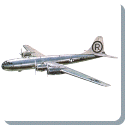 B-29 Superfortress — The B-29 Superfortress, of which almost 4,000 were built during World War II, flew at 644 km/h (400 mph) and had the ability to carry a 907-kg (2,000 lb) bombload for 8,583 km (5,333 mi).
B-29 Superfortress — The B-29 Superfortress, of which almost 4,000 were built during World War II, flew at 644 km/h (400 mph) and had the ability to carry a 907-kg (2,000 lb) bombload for 8,583 km (5,333 mi).
The Boeing B-29 Superfortress was a four-engine heavy bomber propeller aircraft flown by the United States Army Air Forces in World War II and other military organizations afterwards. The name “Superfortress” was derived from its well-known predecessor, the B-17 Flying Fortress.
The B-29 Boeing Model 345 (earlier models were not accepted) was one of the largest aircraft to see service during World War II. It was one of the most advanced bombers of its time, featuring innovations such as a pressurized cabin, a central fire-control system, and remote-controlled machine gun turrets. It was designed as a high-altitude daytime bomber, but flew more low-altitude nighttime incendiary bombing missions. It was the primary aircraft in the U.S. firebombing campaign against Japan in the final months of World War II, and B-29s carried the atomic bombs that destroyed Hiroshima and Nagasaki. Unlike many other bombers, the B-29 remained in service long after the war ended, a few being employed as flying television transmitters for Stratovision. By the time it was retired in the 1960s, some 3,900 planes had been built.
The airframe was further developed into the B-50 for the USAF, and the Soviet Union developed a virtual carbon copy Tupolev Tu-4 which was reverse engineered from confiscated B-29 airplanes
History: World War II
Boeing B-29 Superfortress “Enola Gay” landing after the atomic bombing mission on Hiroshima, Japan.The initial plan, implemented at the direction of President Roosevelt as a promise to China and called Operation Matterhorn, was to use B-29s to attack Japan from four forward bases in southern China, with five main bases in India, and to attack other targets in the region from China and India as needed. The Chengdu region was eventually chosen over the Guilin region to avoid having to raise, equip, and train fifty Chinese divisions to protect the advanced bases from Japanese ground attack. The XX Bomber Command, initially intended to be two combat wings of four groups each, was reduced to a single wing of four groups because of the lack of availability of aircraft, automatically limiting the effectiveness of any attacks from China.
This was an extremely costly scheme, as there was no overland connection available between India and China, and all the supplies had to be flown over the Himalayas. B-29s started to arrive in India in early April 1944. The first B-29 flight to airfields in China (over the Himalayas, or “The Hump”) took place on 24 April 1944. The first B-29 combat mission was flown on 5 June 1944, with 77 out of 98 planes launched from India bombing the railroad shops in Bangkok (Five B-29s were lost to non-combat causes).
On 15 June 1944, 47 B-29s launched from Chengdu in China bombed the Imperial Iron and Steel Works at Yawata, Japan. This was the first attack on Japanese islands since the Doolittle raid in April 1942. The first B-29 combat loss occurred during this raid, with one B-29 destroyed on the ground by Japanese fighters after an emergency landing. Because of the extreme cost of operations, the raids against Japan from Chinese airfields continued at relatively low intensity. Japan was bombed on: 7 July 1944 (14 B-29s), 29 July (70+), 10 August (24), 20 August (61), 8 September (90), 26 September (83), 25 October (59), 12 November (29), 21 November (61), 19 December (36) and for the last time on 6 January 1945 (49). B-29s were withdrawn from airfields in China by the end of January 1945. Throughout this period B-29 raids were also launched from China and India against many other targets throughout Southeast Asia. However, the entire B-29 effort was gradually shifted to the new bases in the Marianas, with the last B-29 combat mission from India flown on 29 March 1945.
The need to use inconvenient bases in China for attacks against Japan ceased after the capture of the Marianas islands in 1944. On the islands of Tinian, Saipan and Guam five major airfields, each constructed as a base for a four-group wing of B-29s, became the launch sites for the large B-29 raids against Japan in the final year of the war. The islands could be easily supplied by ship. The first B-29 arrived on Saipan on 12 October 1944, and the first combat mission was launched from there on 28 October 1944, with 14 B-29s attacking the Truk atoll. The first mission against Japan from bases in the Marianas was flown on 24 November 1944, with 111 B-29s sent to attack Tokyo. From that point, ever more intense raids were launched regularly until the end of the war. These attacks succeeded in devastating all large Japanese cities (with the exception of Kyoto) and gravely damaged Japan’s war industries. Although less appreciated, the aerial mining program carried out by B-29s against Japanese shipping routes and harbor approaches had profoundly degraded Japan’s ability to support its population and fight the war.
Perhaps the most famous B-29 is the Enola Gay, which dropped the atomic bomb ‘Little Boy’ on Hiroshima on 6 August 1945. Bockscar, another B-29, dropped ‘Fat Man’ on Nagasaki three days later. Both aircraft were handpicked for modification from the assembly line at the Omaha plant that was to become Offutt Air Force Base.
The B-29 was used in World War II only in the Pacific Theatre.
 Kids Portal For Parents India Kids Network
Kids Portal For Parents India Kids Network
